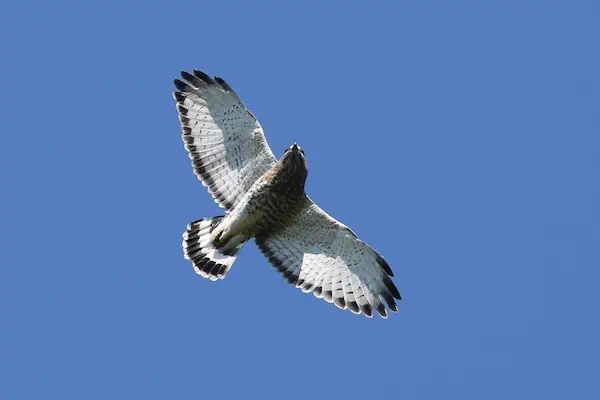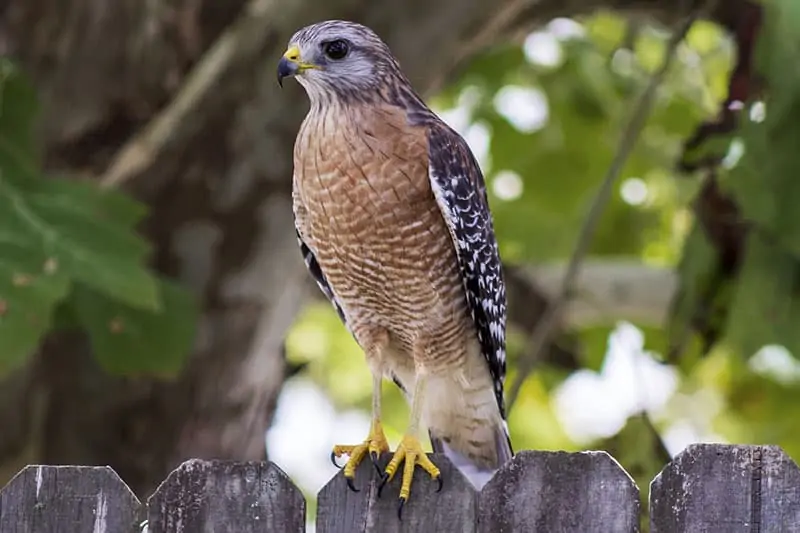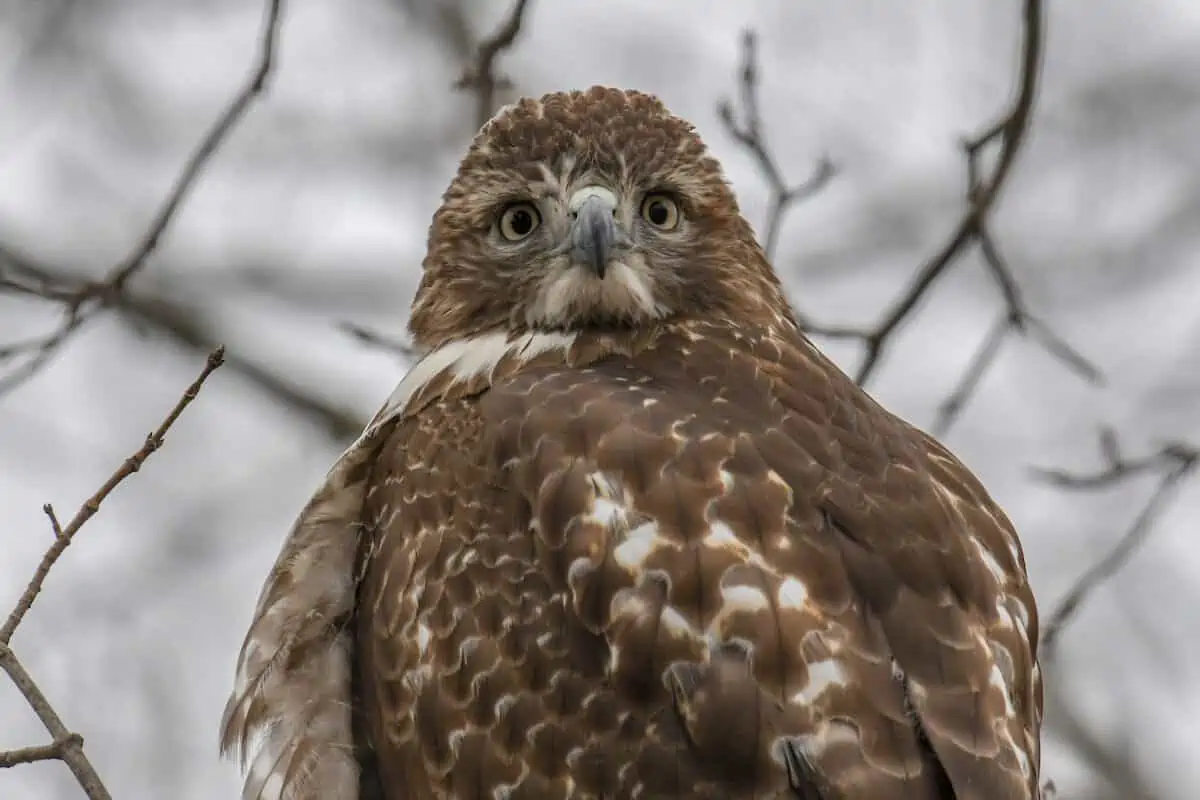Hawks are one of the many kinds of meat-eating raptors that we call birds-of-prey. Their keen hearing, sight, and beak and talons make them exceptional predators in every way. In the United States, there are about 16 different types of hawks. However, the 8 different types of hawks found in Michigan will be discussed in this article.
8 HAWKS IN MICHIGAN
The broad-winged hawk, Coopers hawk, northern goshawk, northern harrier, red-tailed hawk, red-shouldered hawk, rough-legged hawk, and sharp-shinned hawk are Michigan’s eight species of hawks.
Let’s take a look at each one.
1. BROAD-WINGED HAWK

Scientific name: Buteo platypterus
Length: 13.4-17.3 in
Weight: 9.3-19.8 oz
Wingspan: 31.9-39.4 in
Only during the spring-summer breeding season do broad-winged hawks migrate north into Michigan. A brown head and chest, barred underparts, and black and white stripes on the tail distinguish these smaller hawks. Their small tail and large wings with pointed tips are visible in the air.
During the breeding season, these hawks prefer to stay hidden. They’ll build nests in remote areas, such as forests and along rivers. Little mammals, insects, and amphibians like frogs and toads make up the majority of their food.
Your best chance of seeing the broad-winged hawk is during their return migration from South America in the autumn. Thousands of birds may be seen circling in the sky in flocks known as “kettles.” You may see them in the woods if you are not in their migration path. Listen for their piercing whistles and you’ll hear them.
2. COOPERS HAWK

Scientific name: Accipiter cooperii
Length: 14.6 – 17.7 in
Weight: 7.8 – 24.0 oz
Wingspan: 24.4-35.4 in
Cooper’s hawks may be found year-round in Michigan and across most of North America. Northern hawk populations may go farther south during the winter. Adults have a red eye, a squared-off head with a black hat, and a bluish-gray back with extensive orange barring on the chest. The eye of immature birds is yellow, the back is brown, and the head and underparts are white. The white underparts have thick brown streaks.
They prefer forests and woodlands, but they seem to be at home in the suburbs as well. Little birds are their primary food source, and they hunt them expertly in the tree canopy. The Cooper’s hawk has been known to attack birds at a bird feeder, particularly starlings, doves, and pigeons, and many people have seen them in their yard.
Cooper’s hawk skeletons show that several of them had previously fractured bones in their chest after crashing through trees and foliage on a fast pursuit after birds.
3. NORTHERN GOSHAWK

Scientific name: Accipiter gentilis
Length: 20.9-25.2 in
Weight: 22.3-48.1 oz
Wingspan: 40.5-46.1 in
Goshawks have a gray back and chest band that extends down the belly, as well as a thick stripe over each eye. Their larger, fiercer cousins are the sharp-shinned and cooper’s hawks. Goshawks, on the other hand, are quiet birds that prefer to stay in the woods rather than face human-populated areas.
Little hawks, birds, mammals, reptiles, and even insects and carrion make up the northern goshawk’s varied diet. Their population is difficult to estimulate since they are rare and have a secretive nature.
They may be found year-round in Michigan’s north, with a reduced presence in the south during the non-breeding season.
4. NORTHERN HARRIER

Scientific name: Circus hudsonius
Length: 18.1-19.7 in
Weight: 10.6-26.5 oz
Wingspan: 40.2-46.5 in
The face of the northern harrier is almost owl-like. This disc-shaped face, which resembles an owl’s, directs sound into its ears to aid it hunt by sound and sight. The long tail and white patch above the tail are two helpful identifying features. Their wings are held in the form of a “V” during flight, which is a trademark style. These birds are described as majestic by Webster’s Dictionary.
This hawk can be seen year-round in southern Michigan, and during the summer breeding season, it may be found in northern Michigan. Marshes, fields, and other wide-open regions are where you’ll most likely see them.
This hawk creates a platform in dense vegetation, such as reeds, willows, sedges, and cattails, unlike many hawks that nest in trees. Males may have two (sometimes more) lovers at once, and both will offer sustenance for the female and her children.
5. RED TAILED HAWK

Scientific name: Buteo jamaicensis
Length: 17.7 – 25.6 in
Weight: 24.3oz – 51.5 oz
Wingspan: 44.9-52.4 in
The most prevalent hawk on the North American continent, red-tailed hawks live in practically every state all year. During the winter, when birds that spent their summer in Canada descend to join the rest of the population in the United States, their population grows even more. Throughout the summer, they breed in Michigan’s northern half, but throughout the rest of the year, they stay in the southern.
Red-tailed hawks are most active during the day and early mornings, and they may be seen flying for prey with their incredible vision or perched along the road on power lines. Small to medium-sized mammals, such as mice, rats, rabbits, and squirrels make up the majority of their diet. Birds and snakes are another option for them.
The tail of an adult is brick-red, making it simple to see, but the tail of a juvenile is brown and white striped. These hawks have a light brown base with a dark brown top. Their breast is streaked with brown and the belly band of darker brown streaks that runs across their midsection may be another distinguishing feature. There are numerous color variations across the country since these hawks are so widespread.
The long scream of the red-tailed hawk has become a symbol for all birds of prey. Their cry is virtually usually employed in films and television as the sound for any hawk or eagle seen on screen.
6. RED-SHOULDERED HAWK

Scientific name: Buteo lineatus
Length: 16.9-24.0 in
Weight: 17.1-27.3 oz
Wingspan: 37.0-43.7
The eastern United States is home to the red-shouldered hawk, which is widespread. and the California coast to the west. They are year-round in Michigan, but during the breeding season, they are more prevalent in the northern part.
The deep red coloring on the breast, which extends down the whole length of their belly with crimson trim, is a helpful identifying characteristic. Down their back and wings, they have dark, almost black feathers. This will be combined with reddish feathers at the summit of their back and “shoulders.” There will be a lot of white barring throughout the midsection, culminating in a heavily barred tail from the mid-back downwards.
Before you see this hawk, listen to it. They emit a high-pitched “kee-aah” scream that is repeated multiple times. It’s been compared to a seagull by certain individuals. When they are frightened, they will scream to establish their territory.
These birds prefer flooded areas and wetlands, where they live and hunt in the forest. Suburban areas with woods mingling with buildings are also good places to look for them. They’re frequently confused with red-tailed hawks, but once you know the distinctions it’s simple to tell them apart.
7. ROUGH-LEGGED HAWK

Scientific name: Buteo lagopus
Length: 18.5-20.5 in
Weight: 25.2-49.4 oz
Wingspan: 52.0-54.3 in
Throughout the autumn and winter, rough-legged hawks may be seen in Michigan. They travel all the way to the northern Arctic when it’s time for them to breed! They’ll nest on cliffs and rocky outcroppings there.
They may be seen perching on poles and fence posts throughout the winter in areas with a lot of room. Mice, voles, and shrews are all hunted here. To get a hover-in-place view of the terrain below them, rough-legged hawks are said to turn into the wind and flap their wings.
8. SHARP SHINNED HAWKS

Scientific name: Accipiter striatus
Length: 9.4-13.4 in
Weight: 3.1-7.7 oz
Wingspan: 16.9-22.1 in
The smallest of the American hawks is the sharp-shinned hawk. They’re still around in southern Michigan year-round, but the majority of the state only gets them during the spring and summer. Little birds and rodents are prey for these hawks, which pursue them through the woods.
They nest in thickly vegetated woods, making them difficult to locate. They may go to a backyard and hunt birds at feeders on occasion. Nevertheless, during fall migration, is the best time to see them. They head south into the United States. In large numbers, they can be found at hawk watch sites from their summer range in Canada.
In their light-colored breasts and black tail, Sharp-shinned Hawks have a blue-gray back with reddish-orange barring. They have a more rounded head and squared-off tail than the cooper’s hawk, which makes them look quite similar.
